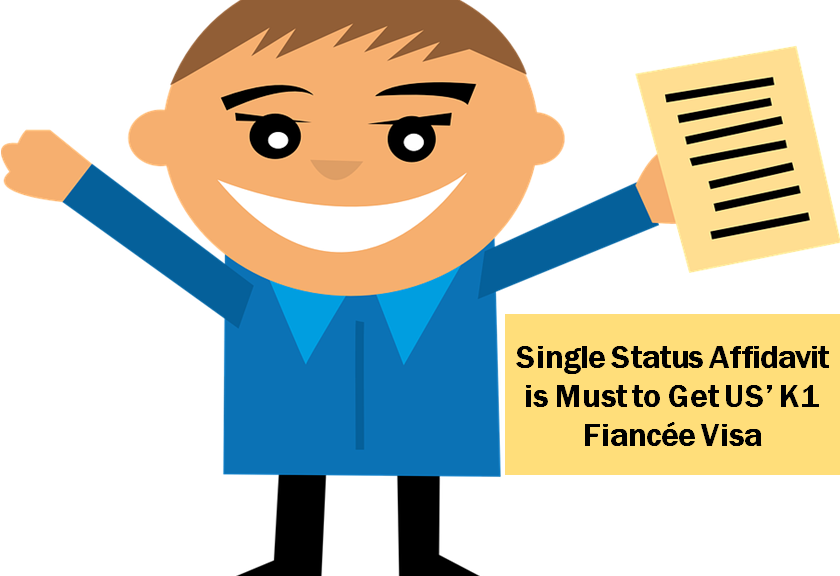
Single Status Affidavit is Must to Get US’ K1 Fiancee Visa
Immigration kicks off a lot of paper –work. Until and unless you don’t complete it, your travel to foreign remains unconfirmed. Be this trip motivated to tour, work or education, you have to meet several formalities with passport as well as visa authority.
Besides aforementioned reasons, matrimony can be another reason to land to the US or any other foreign country. Without prior knowledge, you can be trapped in legal problems there. Since the immigration rules have been made stricter than ever, it’s better to come across every formality that you would be met with.
Here, you can catch the roundup of K1 fiancee visa that is applied before landing to the US for marriage purpose. The USCIS (US Citizen and Immigration Services) – the immigration authority of the US, scrutinizes the intentions of the foreigner before nodding. Then, that foreigner would be permitted to wedlock. Afterwards, the right to obtain green-card is all his/hers.
What is k1 Fiancee Visa?
As aforesaid, this visa is a non-immigration visa. It is specifically drawn to travel to the USA and get married with its citizen. The US citizen sponsors it. It’s mandatory that the wedding must be solemnized within 90 days of arrival to the same country.
Adjustment of Status (AOS) a must:
Once the expat enters on Fiancee visa, he/she has to file for Adjustment of Status (AOS). This formality is mandatory. Without it, the expat can’t acquire green card of the US which identifies the permanent resident status.
The visa holder must solemnize marriage within stipulated time of 90 days. If so does not happen, the USCIS can detain or initiate the process of deportation. And if the wedding occurs within the said duration, the expat must file an application for Adjustment of Status that delivers a right of citizenship to him/her.
Which supporting documents are required to get k1 visa:
- Copy of approval of I-129
- Copy of spouse’ I-131 & I-765
- Copy of marriage certificate
- Single status affidavit
- Copy of foreign spouse’ birth proof
- 2-Passport sized photos with full name
- Copy of EAD cards
- Police verification form
The affidavit of single status out of all these supporting documents can be procured from the court or sub-divisional magistrate, if in India. Thereafter, it requires attestation from HRD of the MEA. It proves that the Indian expat is single by marital certificate. This eligibility is proved through the affidavit or the bachelorhood certificate India. In other countries, it may be known with different names, like certificate of no marriage.
Forms:
- Form I-485
What: It’s an application to change the status of expat from foreigner to the citizen. It’s noteworthy that the expat is eligible to apply for Adjustment of Status (AOS) even if the Fiancee visa is expired, i.e. within the 90 days of arrival. The only thing to be kept in mind is that the person should be married with the US native.
Why essential: The expat becomes eligible to hold citizenship automatically post marriage. The status must be changed while being in the US. The applicant can submit the application in the US consular office. If he/she does not do so or the fiancée visa expires, his/her stay would be considered as unlawful. The USCIS can deport him/her.
- Form G-325A
What: It’s the form describing the biographic details of the expat. However, he/she would have already submitted such details while applying for fiancée visa. But it requires updates. Post marriage, the expat needs to upgrade & submit it.
Why essential: The USCIS requires updated status of every individual living in the US. This form modifies the status from emigrant to the US citizen.
- Form I-864
What: This form is the affidavit of support that states the assets, funds and income of the foreign spouse. It mentions the details of the recent tax returns and W2’s form along with other details.
Why essential: The US law has a norm to specify the financial particulars of the US spouse & the expat’s. This norm mandates disclosure of financial support that must exceed 125% or above the poverty guideline rate. If the income and assets don’t qualify the norm, a co-sponsor can contribute but to a definite limit. The co-sponsor can be more than one.
- Form I-693
What: It’s a medical examination & vaccination report. The expat has to undergo medical checkup while seeking Fiancee visa. It is obtained from the civil surgeon who is authorized by the USCIS to be submitted with AOS form.
Why essential: It determines that the expat is physically fit and healthy. His/her blood has no traces of communicable disease and he/she is vaccinated as per requirement of the law. If the certificate has been obtained earlier when applied for fiancée via, no medication test would be required. The certification will be mandatory.
- Form I-765
What: This form discloses the work permit which is also known as the Employment Authorization Document (EAD). It is not mandatory. Any expat is not permitted to work until he/she has obtained EAD or legal permanent residency, whichever is obtained first.
Why essential: It is required to get approval to work in the US. Unlike AOS, this permit can be applied shortly after entering the territory of the US on K1 visa. For seeking it, the expat needs Social Security Number but needs not require the EAD.
- Form I-131
What: It’s a travel permit. You can call it the Advance Parole. It is not a mandatory document.
Why essential: It allows the expat to work (via I-765) and travel across the US.
 this is link
this is link